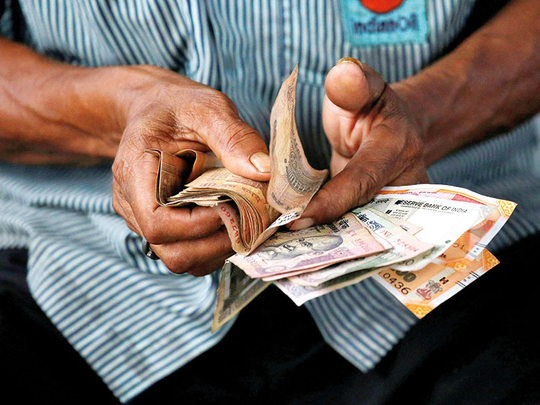
Dubai: India has many options to scale back rapid fall in the currency be it an interest rate hike or a bond buying by the central bank or limit imports, but none seems to be coming by far.
The Indian rupee has been hurt along with currencies of other emerging markets, like Turkish lira and Argentine peso. The Indian currency has shed 13.81 per cent in value since the year so far, making it the worst performer in Asia. On Tuesday, Indian rupee continued its losing streak to 0.08 per cent lower at 72.6950. The currency is not far away from its all-time low of 72.9675 that was struck on September 18.
“The problems for the currency are wide and not idiosyncratic to the rupee alone, for example investors over the past month have attacked currencies that belong to markets known to suffer with high currency account deficits, with this including the rupee, Indonesian rupiah and even as far as the Turkish lira, just to name a few,” Jameel Ahmad, global head of currency strategy and market research at FXTM told Gulf News.
The Turkish lira has also shed 62.14 per cent of its value, while Argentine peso has eroded 111 per cent of its value since January 1.
Even though the woes in Indian rupee is also reflected in other emerging markets, no major policy announcement has been forthcoming so far apart from a couple of central bank interventions.
The options that the central bank has are many, which includes hiking interest rates, which the Reserve Bank of India will decide in the next policy meeting or resort to bond buying, or even to limit oil imports.
“If I had to side with what measure authorities could take to encourage a change of fortunes in the Rupee I would lean more towards an interest rate increase from the Reserve Bank of India rather than resorting to bond buying programs, because I don’t think the currency weakness of 12 per cent year-to-date is as disastrous in the greater scheme of things,” Ahmad said.
Interest rate hike normally clips inflation and curbs liquidity to a certain extent that means the availablity of the rupee is curtailed, resulting in less dollar demand, propping-up the local currency. If the central bank resorts to bond buying then it is expected to boost dollar yields and resulting in higher liquidity from foreign institutions chasing yields in debt.
Reports suggested that federal government was inclined to cut imports of goods including electronics and steel to reduce demand for dollars and help bolster the rupee.
“The slide in the Indian rupee indicates that the measures announced by the government were seen by the markets as underwhelming. While trade and inflation data for August was encouraging, high oil prices and higher US rates will continue to pressure the currency, and we expect further measures to be announced as soon as the next meeting,” Magdalene Teo, Fixed Income Analyst Asia, Julius Baer said. The RBI raised rates in its August meeting by 25 basis points to 6.5 per cent. The next meeting is due on October 5.
Investors in Indian stock market, which hit record highs earlier, are also using the currency depreciation as an opportunity to take profits.
On Monday, the benchmark Sensex index shed more than 1,500 points, but stabilised a day later and closed 0.96 per cent higher at 36,652.06.
The Sensex index is still 2,000 points down from the record of 38,989.65 struck in late August.












